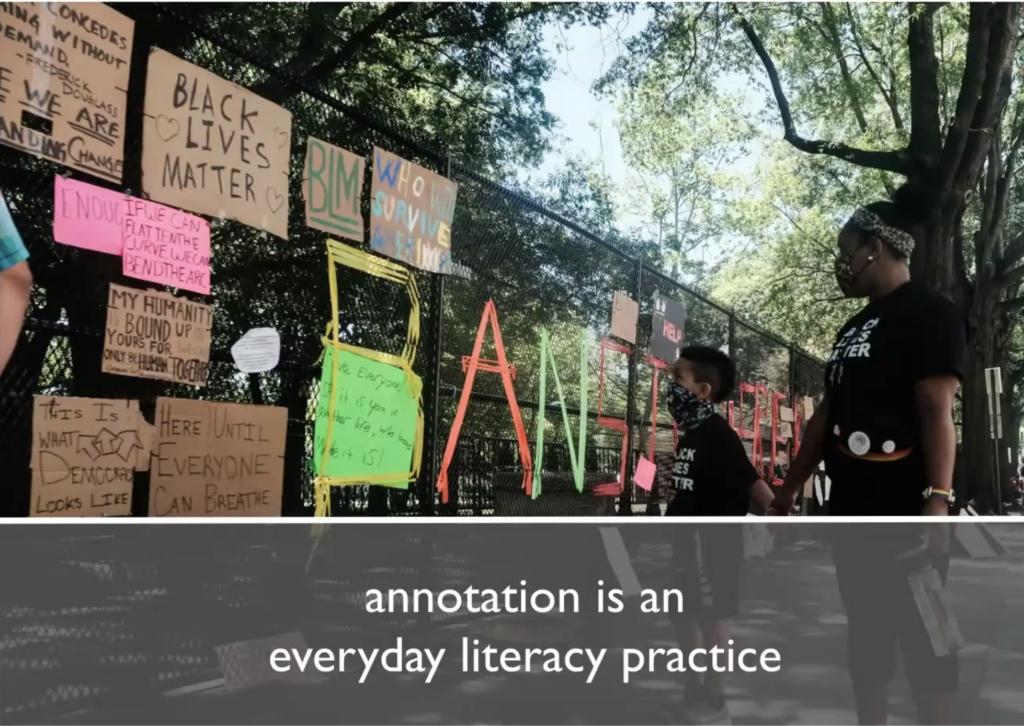This week’s centerpiece was a talk by Remi Kalir on social annotation. Social annotation involves the process of collaboratively adding insights retrospectively to existing texts in a forum with some degree of public accessibility, whether it be free to the general public or accessed by a more restricted group. As part of his definition of social annotation, Kalir invoked public protest art like that pictured below as an example of annotation in a social space as a method of making statements through existing cultural artifacts.

The reframing of protests like this as annotation is clearly applicable and brings a certain sense of intellectual satisfaction, but at the level of depth Kalir was able to convey in the talk, I am left unclear on what exactly the framework does to expand our understanding of these acts. Interpreting these signs as annotations is a different way of looking at these signs which I would normally understand as public art or political speech, but I am unclear on how it might be a better or worse way of seeing them. I would hardly consider this a criticism though, as I assume these questions are answered in Kalir’s book on annotations.
The main digital aspect of the talk is hypothes.is, a tool for shared annotation of digital resources that allows people within a group to make annotations on existing texts and see the annotations that others within the group have made. I have experience using Perusal, an online platform that is executed differently but can be summarized identically. The course I am taking that uses Perusal fails to incorporate it into it’s educational design, mainly because the instructor implemented it at the request of some students and had never heard of it before the class started. In that course group, you can find notes on the readings from precisely 1 student, and, to be completely honest, I’m judging them the whole time. They always do the readings before me and I always see their comments and think “that one’s a bit shallow,” or “that’s not really what the auther is saying,” or “that point already gets addressed a couple of pages later.” I do consider this a me problem; the point of social annotation as a vehicle for learning is not to share your most polished insightful musings or, for that matter, to read other people’s annotations with a critical eye to rate them out of ten. Social annotation requires both vulnerability and a willingness to engage in a way that doesn’t punish vulnerability, and I will be the first to admit I have work to do on both fronts in this context.

Social annotation, like many other progressive educational practices, can only be as powerful as a student’s willingness or capacity to engage with it. Education as we know it is designed to revolve students experiences around grades and deadlines; the goal of classes is, from the perspective of incentive sets at play, to get the highest grades by doing the fastest (which often means least) work. I aim for high grades to earn and maintain scholarships that cover the cost of my tuition while my physical disability makes it difficult to work, so I feel particularly vulnerable to how these incentive sets shape our educational experiences. Even keeners who always go for an A+ will focus on completing objectives and no more, because doing more means you have less capacity to spare for the next required task on the list, disability or not.
I’m just a bit too prideful to use Perusal to write whatever comes to my head, and I’m not getting a grade for writing out constructed, insightful responses to the texts, so I keep my notes to myself. Rather than a criticism of the technology, I consider this an assessment of how my profile as a student ends up pulling me away from educational practices that require active engagement without concrete guidelines to be successful. The only way for progressive educational practices like social annotation to make an impact is as a part of a fundamental shift in educational priorities away from benchmarks and deadlines.